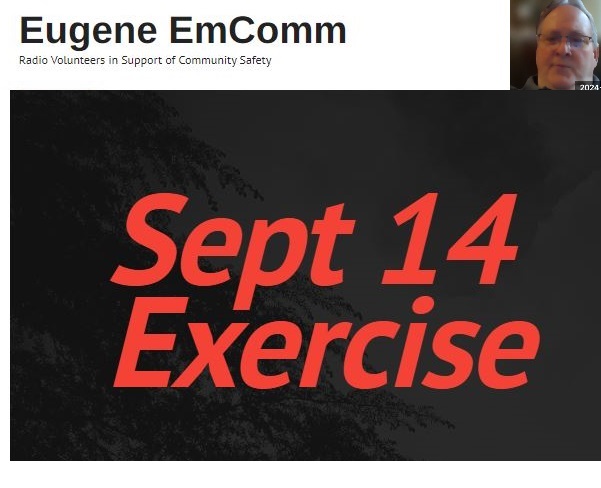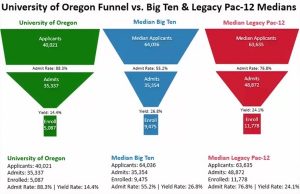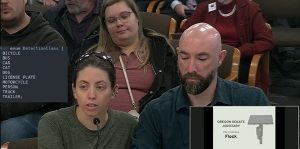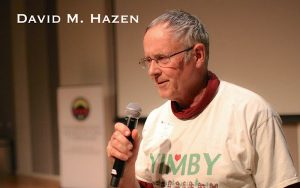Volunteers prepare for 4th annual citywide disaster exercise
6 min read
Eugene-Springfield neighborhoods will conduct their fourth annual citywide preparedness exercise Oct. 19. In an emergency, city residents can survey the immediate neighborhood, then use handheld and ham radios to share information about damage and injuries with emergency responders.
They’ll conduct a run-through Saturday, Sept. 14, in advance of the Oct. 19 exercise.
[00:00:24] Andy Davis (Northeast Neighbors): It’s going to start a little bit before 10, 9:30, the goal is for each of the district net controls and each of the neighborhood hams and each of the neighborhood damage assessment teams to start at 9:30 to do radio checks, make sure the radios are on the right channel, and that everybody can hear everybody before 10 o’clock.
[00:00:45] In the past two exercises, when we started at 10, we had some difficulty because people were having problems making radio contact with their counterparts, and it was like 10:30 and they were still working on that problem.
[00:01:00] We have built in that we encourage people to at minimum, at least once a month, do a neighborhood radio FRS (Family Radio System) net within their group and just to test out the radios, make sure they’re working and reinforce the learning that they have learned how to use the FRS radio at least minimum once a month. So that when we get to an exercise, it’s not like a crash course: ‘How did I do this?’ So that’s the goal.
[00:01:27] And then about 9:45, I will come on the air and I have a script that I will read out to the community that may be listening on this repeater channel.
[00:01:39] Now, I’ll say: ‘Good morning. This is Andy, Kilo Juliet 7 Juliet Delta November in the Northeast Neighbors, Northeast District of Eugene, net control operator for today’s dry run exercise of the Eugene Emergency Communications system. Radio communications can become an important alternate method of communication if traditional telephone and cell phone lines are disrupted.’
[00:02:06] I will continue. I’ll say: ‘This dry run exercise exists to provide training related to emergency communications for Eugene emergency management personnel and the city’s volunteer EmComm members in preparation for next month’s great American ShakeOut citywide EmComm exercise.
[00:02:29] ‘Today’s exercise will be from 1000 to 1200 hours on frequency 146.880 MHz with a 100 Hz tone. In the event of loss of this repeater at any time, the alternate frequency is 147.46 MHz simplex.
[00:02:49] ‘This is an exercise. All message traffic passed and heard on this frequency is not real and is only an exercise. I want to thank all ham radio operators for standing by to give us a clear operating frequency for this dry run exercise,’ and then I finish up: ‘This is Andy KJ7JDN Northeast Neighbors, Northeast District of Eugene, net control for today’s dry run exercise of the Eugene emergency communication system.’
[00:03:22] So, that’s what I’m going to preface at about 9:45 to everybody, and then from there, I’ll say, ‘And I will now begin doing radio checks of each of the Eugene district net controls.’ And I’ll be starting with the Northwest district, and I’ll go through each of the districts.
[00:03:40] After I have established communications with each of the district net control hams, then I will let them let them know that they need to start collecting message traffic from the neighborhoods, and not to call me. I will call them first. So, I will go through each of the districts one by one, polling them for messages and then take their information.
[00:04:06] John Q: Neighborhood survey teams can practice collecting damage assessment information, and recording it on Incident Command System forms, the same forms familiar to ICS teams nationwide.
[00:04:17] In previous exercises, Map Your Neighborhood block captains checked nearby homes for signs that say either ‘Help’ or ‘Okay.’ Two-person teams, including a trained Community Emergency Response Team (CERT) member, can also log infrastructure damage.
[00:04:31] One neighborhood is considering how to identify impassable roads, and recommend alternative evacuation routes.
[00:04:39] Andy Davis (Northeast Neighbors): We’re time-constrained; we’re limiting each of the neighborhoods’ damage assessment teams to three messages. I think that’s adequate. This time, the goal is to be able to relay the message following the ICS 213 (form), starting with Block 2 and actually identifying blocks, say, ‘Block 2, EOC. Block 3,’ and then give what’s in Block 3 and all the way down to Block 8. That’s the goal this time, to make sure that they follow the blocks.
[00:05:12] In times past, messages being passed were all over the place. And so, we want to make sure that we have a standard. And the other goal is that if you send a message, make sure you log it on a radio log. We want the folks to get used to that as well.
[00:05:30] So that’s the two goals and neighborhoods that are actually using the message identifiers, then they will also be using that as well. I’m not sure if all neighborhoods are up to that yet. I know that we in the Northeast, we’ve been practicing using the message identification.
[00:05:48] Two exercises ago that the Emergency Management Office recommended that there be some kind of a message identification so they would have a idea of the geographical location that message came from. So that’s what we’ve done.
[00:06:02] And then once that’s all done, 1:00 p.m., we’re going to have a Zoom debrief, that’ll give people time from 12 to 1 that they are out mobile somewhere for them to get back in front of the computer and then get onto the Zoom for a debrief.
[00:06:20] The length of debrief is actually, it’s up to the participants. So there’s no time limit. I know people’s time is precious and I’m aware of that and I’m sensitive to that. I don’t want to take too much of their time up on Saturday, but if participants have questions, I want to make sure that they’re answered. We want to make sure that everybody’s on the same page, basically.
[00:06:44] John Q: Organizers have improved the event each year.
[00:06:48] Andy Davis (Northeast Neighbors): We didn’t have a dry run on the first one, and the participants or the community suggested that we have a dry run prior to the second exercise. And so we said, ‘Okay, okay, that makes sense. If you folks want to have a drive around and go through like a dress rehearsal, so to speak, that’s fine. We can do that.’ And so we’ve put in a dress rehearsal.
[00:07:13] Those attachments I had on emails for those individuals, they can download and make as many copies they want, and use the directions for those forms are there as well. That tells them what goes in each of the blocks.
[00:07:25] Here in the Northeast, we have training at least once a month on the fourth Wednesday of each month 7 p. m., we’ve been doing Zoom trainings for FRS radios and other things. So it’s open to the public, using the link that’s on the Eugene EmComm.org page. We have FRS training and it’s open to anybody. and I have training also once a month at Norkenzie (Christian Church, 2530 Crescent Ave.). I had training on filling out the ICS 213.
[00:07:59] John Q: Andy said there’s also a new twist for the 2024 city-wide disaster drill.
[00:08:04] Andy Davis (Northeast Neighbors): We have something new this year that we thought we’d do. The city emergency management, with what staff that they are able to assemble, they have to scramble to find another suitable emergency operation center to spool up, so to speak.
[00:08:21] We’re following the community neighborhood radio resource guide, which states that in the event that the EOC is not operational—it could be up to two days, depending on personnel getting to the EOC—that the first ham district net control assumes net control. And so we’re going to use that part of the guide and put that into this scenario.
[00:08:45] We should always plan for different scenarios and so we thought we’d throw that in this time, just to see how that works.
[00:08:53] John Q: Facing more frequent wildfires, winter storms, atmospheric rivers, and a really big earthquake, local residents are preparing to help with response and recovery. To learn more, contact the CERT program, your neighborhood association, or your city’s emergency manager.




